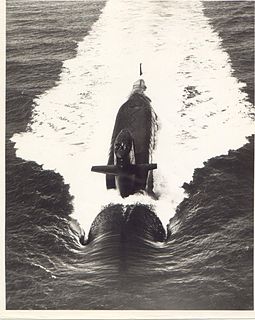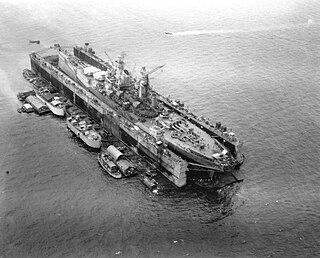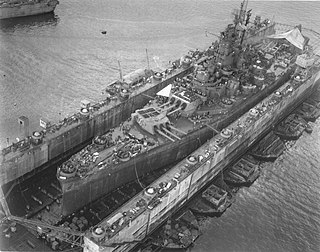
A dry dock is a narrow basin or vessel that can be flooded to allow a load to be floated in, then drained to allow that load to come to rest on a dry platform. Dry docks are used for the construction, maintenance, and repair of ships, boats, and other watercraft.

USS Robert E. Lee (SSBN-601), a George Washington-class fleet ballistic missile submarine, was the only ship of the United States Navy to be named for Robert E. Lee (1807–1870), the commanding general of the Confederate forces during the American Civil War.

USS George C. Marshall (SSBN-654), a Benjamin Franklin-class ballistic missile submarine, was the only ship of the United States Navy to be named for General of the Army George C. Marshall (1880-1959), who served as U.S. Secretary of State from 1947 to 1949 and as U.S. Secretary of Defense from 1950 to 1951.

USS Batfish (SS/AGSS-310) is a Balao-class submarine, known primarily for the remarkable feat of sinking three Imperial Japanese Navy submarines in a 76-hour period, in February 1945. USS Batfish is the first vessel of the United States Navy to be named for the batfish, a fish found off the coast of Peru, at depths ranging from 3 to 76 metres.

USS Artisan (ABSD-1), later redesignated as (AFDB-1), was a ten-section, non-self-propelled, large auxiliary floating drydock of the United States Navy. The only U.S. warship with this name, Artisan was constructed in sections during 1942 and 1943 by the Everett-Pacific Shipbuilding & Dry Dock Company, in Everett, Washington; the Chicago Bridge & Iron Company, in Eureka, California; the Pollock-Stockton Shipbuilding Company, in Stockton, California; and the Chicago Bridge & Iron Company, in Morgan City, Louisiana. This ship was commissioned at Everett, Washington, on 10 May 1943, Captain Andrew R. Mack in command. With all ten sections joined, she was 927 feet long, 28 feet tall, and with an inside clear width of 133 feet 7 inches.

USS White Sands (ARD-20), ex-USS ARD-20, ex-USS ARD(BS)-20, later AGDS-1, was a United States Navy auxiliary repair dock in service from 1944 to 1947 and from 1966 to 1974 and an Auxiliary floating drydock.
Submarine Squadron 14 , was a United States Navy submarine squadron.

USS ARD-29 was an auxiliary repair dock that served with the United States Navy during World War II as an Auxiliary floating drydock. In 1967, the ship was renamed Arco, and in the 1970s the vessel was first loaned, and later sold, to Iran.

USS Waterford (ARD-5) was an Auxiliary floating drydock that served in the United States Navy during World War II, the Korean War, the Vietnam War, and the Persian Gulf War. She later served the Chilean Navy as Talcahuano (133).

An auxiliary floating drydock is a type of US Navy floating dry dock. Floating dry docks are able to submerge underwater and to be placed under a ship in need of repair below the water line. Water is then pumped out of the floating dry dock, raising the ship out of the water. The ship becomes blocked on the deck of the floating dry dock for repair. Most floating dry docks have no engine and are towed by tugboats to their destinations. Floating dry docks come in different sizes to accommodate varying ship sizes, while large floating dry docks come in sections and can be combined to increase their size and lift power. Ballast pontoon tanks are flooded with water to submerge or pumped dry to raise the ship.

YFD-2 was an auxiliary floating drydock built for the United States Navy in 1901. The first parts were laid down in early 1901 at Maryland Steel Co. of Sparrows Point, Maryland. YFD-2 was the first of its kind, steel movable auxiliary floating drydock, used to raise large ships out the water for repair below the ship's waterline. YFD-2 had a 18,000 tons lifting capacity.

USS ABSD-2, later redesignated as AFDB-2, was a ten-section, non-self-propelled, large auxiliary floating drydock of the US Navy. Advance Base Sectional Dock-2 was constructed in sections during 1942 and 1943 by the Mare Island Naval Shipyard in Vallejo, California for World War II. Her official commissioning ceremony took place on 14 August 1943 with CDR. Joseph J. Rochefort in command. With all ten sections joined, she was 927 feet long, 28 feet tall, and with an inside clear width of 133 feet 7 inches. ABSD-2 had a traveling 15-ton capacity crane with an 85-foot radius and two or more support barges. The two side walls were folded down under tow to reduce wind resistance and lower the center of gravity. ABSD-2 had 6 capstans for pulling, each rated at 24,000 lbf (110,000 N) at 30 ft/min (0.15 m/s), 4 of the capstans were reversible. There were also 4 ballast compartments in each section.

ABSD-3 is an advanced base sectional dock, constructed of nine advance base dock (ABD) sections for the US Navy as an auxiliary floating drydock for World War II. ABSD-3 was delivered to the US Navy in April 1944, and was commissioned on 27 October 1944. Advance Base Sectional Dock-3 was constructed in sections during 1942 and 1943.

ABSD-6 is an advanced base sectional dock which was constructed of nine advance base docks (ABD) sections for the US Navy as an auxiliary floating drydock for World War II. ABSD-6 was built by Mare Island Naval Shipyard at Vallejo, California. ABSD-6 was commissioned on 28 September 1944. Advance Base Sectional Dock-6 was constructed in sections during 1942 and 1943. Each section are 3,850 tons and are 93 feet long each. Each Section had a 165 feet beam, a 75 feet molded depth and had 10,000 tons lifting capacity each. There were 4 ballast compartments in each section. With all nine sections joined, she was 825 feet long, 28 feet tall, and with an inside clear width of 133 feet 7 inches. ABSD-2 had a traveling 15-ton capacity crane with an 85-foot radius and two or more support barges. The two side walls were folded down under tow to reduce wind resistance and lower the center of gravity. ABSD-6 had 6 capstans for pulling, each rated at 24,000 lbf (110,000 N) at 30 ft/min (0.15 m/s), 4 of the capstans were reversible.

USS ABSD-4, later redesignated as AFDB-4, was a nine-section, non-self-propelled, large auxiliary floating drydock of the US Navy. Advance Base Sectional Dock-4 was constructed in sections during 1942 and 1943 by the Mare Island Naval Shipyard in Vallejo, California for World War II. With all ten sections joined, she was 927 feet long, 28 feet tall, and with an inside clear width of 133 feet 7 inches. ABSD-4 had a traveling 15-ton capacity crane with an 85-foot radius and two or more support barges. The two side walls were folded down under tow to reduce wind resistance and lower the center of gravity. ABSD-4 had 6 capstans for pulling, each rated at 24,000 lbf (110,000 N) at 30 ft/min (0.15 m/s), 4 of the capstans were reversible. There were also 4 ballast compartments in each section.

USS ABSD-5, later redesignated as AFDB-5, was a nine-section, non-self-propelled, large auxiliary floating drydock of the US Navy. Advance Base Sectional Dock-5 was constructed in sections during 1943 and 1944 by the Chicago Bridge & Iron Company in Morgan City, Louisiana for World War II. With all nine sections joined, she was 825 feet long, 28 feet tall, and with an inside clear width of 133 feet 7 inches. ABSD-5 had two traveling 15-ton capacity crane with an 85-foot radius and two or more support barges. The two side walls were folded down under tow to reduce wind resistance and lower the center of gravity. ABSD-5 had 6 capstans for pulling, each rated at 24,000 lbf (110,000 N) at 30 ft/min (0.15 m/s), 4 of the capstans were reversible. There were also 4 ballast compartments in each section.
Pollock-Stockton Shipbuilding Company was established in 1942 to build ships needed for World War II. As part of the Emergency Shipbuilding Program the US Navy provided some of the capital to start Pollock-Stockton Shipbuilding at Stockton, California. The shipyard was located at San Joaquin River and Stockton Channel, near Louis Park. After the war the shipyard closed down in February 1946.

USS Moctobi (ATF-105) was an Abnaki-class of fleet ocean tug. She served in World War II, Vietnam, and Korea, the last two of which she received battle stars. She was scrapped in 2012.

Naval Advance Base Espiritu Santo or Espiritu Santo Naval Base, most often just called Espiritu Santo, was an advance Naval base that the U.S. Navy Seabees built during World War II to support the allied effort in the Pacific. Espiritu Santo Naval Base was located on the island Espiritu Santo in the New Hebrides, now Vanuatu in the South Pacific. The base also supported the U.S. Army and Army Air Corps, U.S. Coast Guard, and US Marine Corps. Espiritu Santo Naval Base was the first large advance base built in the Pacific. By the end of the war it had become the second-largest base in the theater. To keep ships tactically available there was a demand for Advance bases that could repair and resupply the fleet at advance locations, rather than bring ships back to the United States. Prior to December 7th, Pearl Harbor was the U.S. fleet's largest advance base in the Pacific. Espiritu became, capable of all aspects necessary to support the Fleet's operations from fleet logistics in fuel, food, and ammunition, to transport embarkation for combat operations or returning to CONUS. The ships repair facilities, and drydocks were capable of attending to most damage and routine maintenance. Had it not existed, ships would have had to return to Pearl Harbor, Brisbane,or Sydney for major repairs and resupply. The base became a major R and R destination for the fleet.

USS Resolute (AFDM-10),, was a AFDM-3-class floating dry dock built in 1945 and operated by the United States Navy.


















